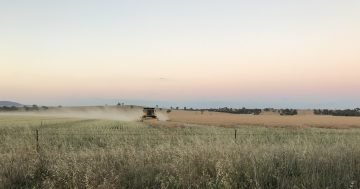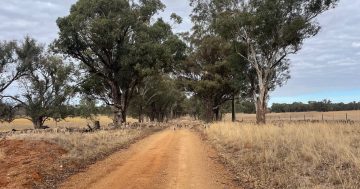
The weekly weather events are impacting farmers in far greater ways than just with their cropping and livestock operations, with destroyed fencing and roads playing havoc with farm operations. Photo: Edwina Mason.
Last weekend’s statewide weather event ended a week of warm and dry weather, the heavy storms unleashing a trail of destruction across the South West Slopes and Riverina – uprooting trees, washing out fences and causing many an operator to abandon their windrowers.
As one Young farmer jokingly said, “It was lucky the rain came because the mud was starting to dehydrate,” but he hasn’t been able to get onto his paddocks in months.
The normally gentle easing into harvest with the windrowing of the beautiful sage-green canola into neat harvestable rows had begun late last week.
But even as late as Tuesday evening, anyone with hopes of resuming work was soon bogged down in the saturated soils with little in the form of respite on the roads to town as they continue to shed their tar for the dirt below.
A survey of the state’s flood-affected farmers has found significant losses across many regions, leading to massive costs as most of the damage is uninsurable.
More than two-thirds of respondents to the NSW Farmers Flood Impacts Survey were experiencing flooding for the second year in a row, with more than three-quarters saying they had planted less than half of their usual winter crop this season in response to the wet weather.
NSW Farmers President Xavier Martin said the financial impact was set to be enormous, with harvesting efforts delayed by several weeks as floodwater continued to wreak havoc on roads and paddocks.
“Farmers are saying they’re a bit over it, frankly, and it’s not hard to see why,” Mr Martin said.
“We know these farms are homes, not just workplaces, and having to deal with the uncertainty, stress and anxiety of living through this ongoing cycle of natural disasters is challenging.
“When you consider farming has been a pretty expensive operation over the past year, and now so much of the food and fibre we have grown has been destroyed or damaged, it’s really tough from both a personal and a business standpoint.”
More than half of the state’s local government areas were subject to natural disaster declarations following another weekend of intense rain and flooding, and most roads were either heavily potholed or closed in parts, including the Newell.
This was having a major impact not only on the movement of trucks and machinery, but also people trying to get about their communities.
Mr Martin said many respondents reported on-farm roads, fences, bridges and culverts would also need to be replaced, with many estimating initial repair bills upwards of $100,000.
“Unfortunately this disaster is not over yet, but we know this year will go down in history not just as one of the worst widespread flooding events we’ve seen,” Mr Martin said.
“A lot of this flood damage cannot be insured against, and we’ll be feeling the impact well into next year in terms of missing the summer sowing window because the ground is still so wet.
“With so many people reporting increased stress and mental health impacts, I’d urge everyone to keep in touch with neighbours. Wellbeing and health support are available, so don’t struggle through this on your own.”
Affected farmers should report any flood damage to their properties to NSW DPI to help get support moving as quickly as possible.
Livestock producers are advised to use the NSW Government Agriculture and Animal Services Functional Area (AASFA) hotline – 1800 814 647 – for immediate assistance for affected farmers, landowners and communities in isolated areas.
To keep up to date with the latest flood information, visit www.nsw.gov.au/floods and to submit an online natural disaster damage survey, click here.









